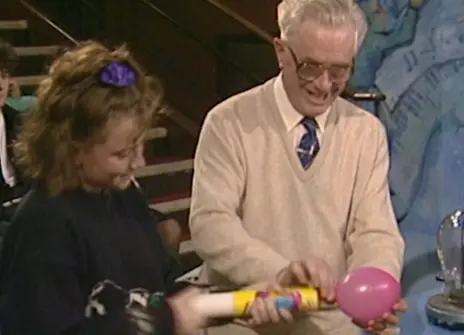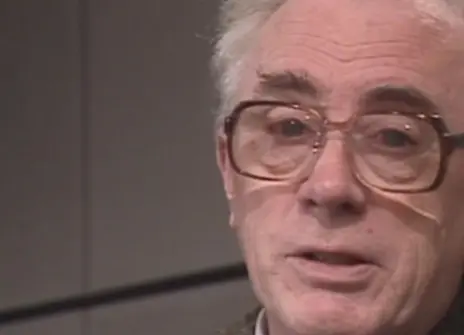Lecture 4 – Technology, trumpets and tunes
Physicist Charles Taylor explores the links between science and music in these CHRISTMAS LECTURES from 1989.
From the 1989 Lecture programme:
Science and Music always seem to be treated as separate subjects by our educational system and yet large numbers of professional scientists are passionately fond of music. I was very lucky because, at school, I was taught music and physics by the same person and so was given a firm foundation for the interest that has remained with me ever since.
Science is sometimes described as the process of asking questions about the world around us and, in this course of lectures, we shall be asking a series of scientific questions about many different aspects of music beginning with perhaps the most difficult of all… 'What is Music?'
It is a fact that every sound from that of the proverbial pin dropping to the almost overpowering sound of a full choir and orchestra in an operatic climax, or from the calm of a lullaby to the deafening frenzy of a pop concert, is produced by changing the pressure of the air by a small amount. These pressure changes travel as waves to the ears of the listeners and when they are perceived by the miraculous ear-brain system they become the sensations we call sound and music.
We shall explore the basic science involved in this journey, starting with the ways in which musical instruments make the pressure changes. We shall investigate the factors that affect the quality of sound produced which stem both from the craftsmanship of the instrument maker and from the skill and artistry of the performer.
The remarkable properties of the ear-brain system have a profound effect on our perception of music and will need to be considered throughout the series. The technology of instruments (from the earliest reed pipes to the latest electronic synthesizers) has influenced the development of music and we shall look at the history of musical instruments with that in mind. Music and musical instruments have developed differently in different parts of the world and modern composers and instrument makers are now learning a great deal from other cultures.
A hundred years or so ago scientists were beginning to think that they understood many aspects of music and during the lectures we shall use some of the fascinating demonstrations from that era… in many cases using the actual apparatus that has survived in the Royal Institution. In 1819, a scientist of that period – Savart – wrote that he thought the time had come when the efforts of scientists and of artists could unite to bring the art of violin making to perfection; but it has taken over 150 years even to achieve the necessary cooperation and we are still far short of perfection. Nevertheless in many areas scientists, musicians and instrument makers are learning to cooperate successfully with each other and, especially in the world of electronic music, there has been astonishing progress even in the last five years or so.
The very complexity of the operation of the ear-brain system sometimes leads to strange results, some of which can be funny and others disturbing. So, although many of the experiments and demonstrations that we shall do in the course of our exploration will appear to be quite objective, it will often be necessary to remind ourselves that we are dealing with very subjective phenomena. The wonderful experience that we call music can only begin to be understood properly if we bring the measurements and observations out of the laboratory and apply them in the real world of performance and listening.
About the 1989 CHRISTMAS LECTURES
Physicist Charles Taylor explores the links between science and music in these CHRISTMAS LECTURES from 1989.
From the 1989 Lecture programme:
Science and Music always seem to be treated as separate subjects by our educational system and yet large numbers of professional scientists are passionately fond of music. I was very lucky because, at school, I was taught music and physics by the same person and so was given a firm foundation for the interest that has remained with me ever since.
Science is sometimes described as the process of asking questions about the world around us and, in this course of lectures, we shall be asking a series of scientific questions about many different aspects of music beginning with perhaps the most difficult of all… 'What is Music?'
It is a fact that every sound from that of the proverbial pin dropping to the almost overpowering sound of a full choir and orchestra in an operatic climax, or from the calm of a lullaby to the deafening frenzy of a pop concert, is produced by changing the pressure of the air by a small amount. These pressure changes travel as waves to the ears of the listeners and when they are perceived by the miraculous ear-brain system they become the sensations we call sound and music.
We shall explore the basic science involved in this journey, starting with the ways in which musical instruments make the pressure changes. We shall investigate the factors that affect the quality of sound produced which stem both from the craftsmanship of the instrument maker and from the skill and artistry of the performer.
The remarkable properties of the ear-brain system have a profound effect on our perception of music and will need to be considered throughout the series. The technology of instruments (from the earliest reed pipes to the latest electronic synthesizers) has influenced the development of music and we shall look at the history of musical instruments with that in mind. Music and musical instruments have developed differently in different parts of the world and modern composers and instrument makers are now learning a great deal from other cultures.
A hundred years or so ago scientists were beginning to think that they understood many aspects of music and during the lectures we shall use some of the fascinating demonstrations from that era… in many cases using the actual apparatus that has survived in the Royal Institution. In 1819, a scientist of that period – Savart – wrote that he thought the time had come when the efforts of scientists and of artists could unite to bring the art of violin making to perfection; but it has taken over 150 years even to achieve the necessary cooperation and we are still far short of perfection. Nevertheless in many areas scientists, musicians and instrument makers are learning to cooperate successfully with each other and, especially in the world of electronic music, there has been astonishing progress even in the last five years or so.
The very complexity of the operation of the ear-brain system sometimes leads to strange results, some of which can be funny and others disturbing. So, although many of the experiments and demonstrations that we shall do in the course of our exploration will appear to be quite objective, it will often be necessary to remind ourselves that we are dealing with very subjective phenomena. The wonderful experience that we call music can only begin to be understood properly if we bring the measurements and observations out of the laboratory and apply them in the real world of performance and listening.





